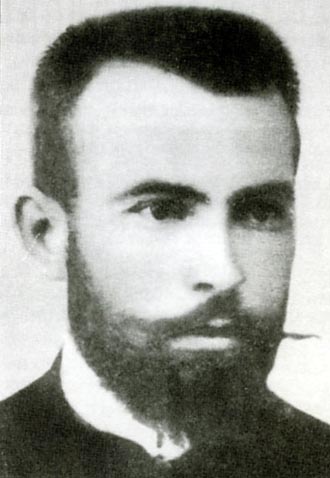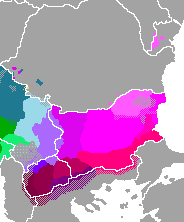|
History Of Bulgarian
The history of the Bulgarian language can be divided into three major periods: * Old Bulgarian (from the late 9th until the 12th century); * Middle Bulgarian (from the 12th century to the 16th century); * Modern Bulgarian (since the 17th century). Bulgarian as a written South Slavic language that dates back to the end of the 9th century. Old Bulgarian Old Bulgarian was the first literary period in the development of the language. It was a highly synthetic language with a rich declension system as attested by a number of manuscripts from the late 10th and the early 11th centuries. Those originate mostly from the Preslav and the Ohrid Literary School, although smaller literary centers also contributed to the tradition. The language became a medium for rich scholarly activity — chiefly in the late 9th and the early 10th century — with writers such as Constantine of Preslav, John Exarch, Clement of Ohrid, Chernorizetz Hrabar and Naum of Preslav (Naum of Ohrid). Most o ... [...More Info...] [...Related Items...] OR: [Wikipedia] [Google] [Baidu] |
Old Bulgarian Language
Old Church Slavonic or Old Slavonic () was the first Slavic literary language. Historians credit the 9th-century Byzantine missionaries Saints Cyril and Methodius with standardizing the language and using it in translating the Bible and other Ancient Greek ecclesiastical texts as part of the Christianization of the Slavs. It is thought to have been based primarily on the dialect of the 9th-century Byzantine Slavs living in the Province of Thessalonica (in present-day Greece). Old Church Slavonic played an important role in the history of the Slavic languages and served as a basis and model for later Church Slavonic traditions, and some Eastern Orthodox and Eastern Catholic churches use this later Church Slavonic as a liturgical language to this day. As the oldest attested Slavic language, OCS provides important evidence for the features of Proto-Slavic, the reconstructed common ancestor of all Slavic languages. Nomenclature The name of the language in Old Church Slavonic ... [...More Info...] [...Related Items...] OR: [Wikipedia] [Google] [Baidu] |
Bulgars
The Bulgars (also Bulghars, Bulgari, Bolgars, Bolghars, Bolgari, Proto-Bulgarians) were Turkic semi-nomadic warrior tribes that flourished in the Pontic–Caspian steppe and the Volga region during the 7th century. They became known as nomadic equestrians in the Volga-Ural region, but some researchers say that their ethnic roots can be traced to Central Asia. During their westward migration across the Eurasian steppe, the Bulgar tribes absorbed other tribal groups and cultural influences in a process of ethnogenesis, including Iranian, Finnic and Hunnic tribes. Modern genetic research on Central Asian Turkic people and ethnic groups related to the Bulgars points to an affiliation with Western Eurasian populations. The Bulgars spoke a Turkic language, i.e. Bulgar language of Oghuric branch. They preserved the military titles, organization and customs of Eurasian steppes, as well as pagan shamanism and belief in the sky deity Tangra. The Bulgars became semi-sedentary durin ... [...More Info...] [...Related Items...] OR: [Wikipedia] [Google] [Baidu] |
Slavic Languages
The Slavic languages, also known as the Slavonic languages, are Indo-European languages spoken primarily by the Slavic peoples and their descendants. They are thought to descend from a proto-language called Proto-Slavic, spoken during the Early Middle Ages, which in turn is thought to have descended from the earlier Proto-Balto-Slavic language, linking the Slavic languages to the Baltic languages in a Balto-Slavic group within the Indo-European family. The Slavic languages are conventionally (that is, also on the basis of extralinguistic features) divided into three subgroups: East, South, and West, which together constitute more than 20 languages. Of these, 10 have at least one million speakers and official status as the national languages of the countries in which they are predominantly spoken: Russian, Belarusian and Ukrainian (of the East group), Polish, Czech and Slovak (of the West group) and Bulgarian and Macedonian (eastern dialects of the South group), and Serbo-C ... [...More Info...] [...Related Items...] OR: [Wikipedia] [Google] [Baidu] |
Macedonian Language
Macedonian (; , , ) is an Eastern South Slavic language. It is part of the Indo-European language family, and is one of the Slavic languages, which are part of a larger Balto-Slavic branch. Spoken as a first language by around two million people, it serves as the official language of North Macedonia. Most speakers can be found in the country and its diaspora, with a smaller number of speakers throughout the transnational region of Macedonia. Macedonian is also a recognized minority language in parts of Albania, Bosnia and Herzegovina, Romania, and Serbia and it is spoken by emigrant communities predominantly in Australia, Canada and the United States. Macedonian developed out of the western dialects of the East South Slavic dialect continuum, whose earliest recorded form is Old Church Slavonic. During much of its history, this dialect continuum was called "Bulgarian", although in the 19th century, its western dialects came to be known separately as "Macedonian". Stan ... [...More Info...] [...Related Items...] OR: [Wikipedia] [Google] [Baidu] |
Balkan Dialects Of Bulgarian
The Balkan dialects are the most extensive group of dialects of the Bulgarian language, covering almost half of the present-day territory of Bulgaria. Their range includes north-central Bulgaria and most of the Bulgarian part of Thrace, excluding the Rhodopes, the region of Haskovo and Strandzha. As a result of the mass population movements that affected eastern Bulgaria during the 19th and the beginning of the 20th century, the Balkan dialects are now spoken also in vast areas of northeastern Bulgaria, especially the regions of Dobrich and Varna. The most significant feature of the dialects, as in most Eastern Bulgarian dialects, is the pronunciation of Old Church Slavonic ѣ (yat) as or , depending on the character of the following syllable. The Balkan dialects, and in particular, the Central Balkan dialect The Central Balkan dialect is a Bulgarian dialect that is part of the Balkan group of the Eastern Bulgarian dialects. Its range includes most of north-central Bulgaria ( ... [...More Info...] [...Related Items...] OR: [Wikipedia] [Google] [Baidu] |
Vernacular
A vernacular or vernacular language is in contrast with a "standard language". It refers to the language or dialect that is spoken by people that are inhabiting a particular country or region. The vernacular is typically the native language, normally spoken informally rather than written, and seen as of lower status than more codified forms. It may vary from more prestigious speech varieties in different ways, in that the vernacular can be a distinct stylistic register, a regional dialect, a sociolect, or an independent language. Vernacular is a term for a type of speech variety, generally used to refer to a local language or dialect, as distinct from what is seen as a standard language. The vernacular is contrasted with higher-prestige forms of language, such as national, literary, liturgical or scientific idiom, or a ''lingua franca'', used to facilitate communication across a large area. According to another definition, a vernacular is a language that has not develope ... [...More Info...] [...Related Items...] OR: [Wikipedia] [Google] [Baidu] |
Athematic
In Indo-European studies, a thematic vowel or theme vowel is the vowel or from ablaut placed before the ending of a Proto-Indo-European (PIE) word. Nouns, adjectives, and verbs in the Indo-European languages with this vowel are thematic, and those without it are athematic. Used more generally, a thematic vowel is any vowel found at the end of the stem of a word. Outside Indo-European, the term "thematic vowel" is also used in the grammar of Kartvelian languages (see Georgian verb paradigm for more information on thematic vowels). Proto-Indo-European PIE verbs and nominals (nouns and adjectives) consist of three parts: :\underbrace_ The thematic vowel, if present, occurs at the end of the suffix (which may include other vowels or consonants) and before the ending: * 'heat' > Ancient Greek (''thérmos'') * '(he) bears' > Sanskrit ''bhárati'', Gothic Athematic forms, by contrast, have a suffix ending in a consonant, or no suffix at all (or arguably a null suffix): * 'fathe ... [...More Info...] [...Related Items...] OR: [Wikipedia] [Google] [Baidu] |
High Middle Ages
The High Middle Ages, or High Medieval Period, was the periodization, period of European history that lasted from AD 1000 to 1300. The High Middle Ages were preceded by the Early Middle Ages and were followed by the Late Middle Ages, which ended around AD 1500 (by historiography, historiographical convention). Key historical trends of the High Middle Ages include the medieval demography, rapidly increasing population of Europe, which brought about great social and political change from the preceding era, and the Renaissance of the 12th century, including the first developments of rural exodus and urbanization. By 1250, the robust population increase had greatly benefited the European economy, which reached levels that would not be seen again in some areas until the 19th century. That trend faltered during the Late Middle Ages because of a Crisis of the Late Middle Ages, series of calamities, most notably the Black Death, but also numerous wars as well as economic stagnation. Fro ... [...More Info...] [...Related Items...] OR: [Wikipedia] [Google] [Baidu] |
East South Slavic Languages
The Eastern South Slavic dialects form the eastern subgroup of the South Slavic languages. They are spoken mostly in Bulgaria and North Macedonia, and adjacent areas in the neighbouring countries. They form the so-called Balkan Slavic linguistic area, which encompasses the southeastern part of the dialect continuum of South Slavic. Linguistic features Languages and dialects Eastern South Slavic dialects share a number of characteristics that set them apart from the other branch of the South Slavic languages, the Western South Slavic languages. This area consists of Bulgarian and Macedonian, and according to some authors encompasses the southeastern dialect of Serbian, the so-called Prizren-Timok dialect. The last is part of the broader transitional Torlakian dialectal area. The Balkan Slavic area is also part of the Balkan Sprachbund. The external boundaries of the Balkan Slavic/Eastern South Slavic area can be defined with the help of some linguistic structur ... [...More Info...] [...Related Items...] OR: [Wikipedia] [Google] [Baidu] |
Second Bulgarian Empire
The Second Bulgarian Empire (; ) was a medieval Bulgarians, Bulgarian state that existed between 1185 and 1396. A successor to the First Bulgarian Empire, it reached the peak of its power under Tsars Kaloyan of Bulgaria, Kaloyan and Ivan Asen II before gradually being conquered by the Ottoman Empire, Ottomans in the late 14th century. Until 1256, the Second Bulgarian Empire was the dominant power in the Balkans, defeating the Byzantine Empire in several major battles. In 1205, Emperor Kaloyan defeated the newly established Latin Empire in the battle of Adrianople (1205), Battle of Adrianople. His nephew Ivan Asen II defeated the Despotate of Epiros and made Bulgaria a regional power again. During his reign, Bulgaria spread from the Adriatic Sea, Adriatic to the Black Sea and the economy flourished. In the late 13th century, however, the Empire declined under constant invasions by Mongols, Byzantine Empire, Byzantines, Hungarians, and Serbia in the Middle Ages, Serbs, as well as i ... [...More Info...] [...Related Items...] OR: [Wikipedia] [Google] [Baidu] |







